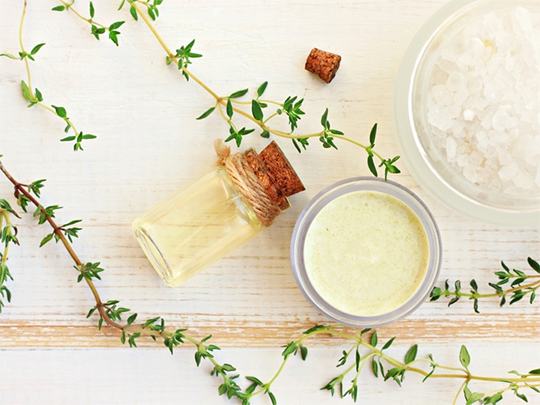It’s thyme for a change (part 2)
Parsley, sage, rosemary and thyme - the lyrics of one of the best-known English ballads sing of the most common herbs. Already in the 17th century people knew about the beneficial effects of thyme. On our journey through thyme we want to stop briefly in 2016 and learn in our Blog part 2 why the active ingredients of thyme are classified as "GRAS"….
As we have already learned in the first part of our blog, you can even discover thyme while hiking on the highest mountains. If you don’t want to exert yourself to find thyme, an aisle to the spice rack is easier. Perceive its irresistible, spicy-aromatic scent while grinding the fresh or dried herb in your hands. Find out which components in thyme determine this characteristic odor and what other kinds of benefits offers this plant to you. Already excited?

Active substance: Thymol
One of the most medically relevant ingredients of thyme is thymol (2-isopropyl-5-methylphenol) with an amount of 30 to 50% in the plant’s essential oils, as shown in Figure 1. In its solid form, thymol forms whitish crystals. It is the main monoterpene phenol occurring in essential oils isolated from plants belonging to the Lamiaceae family like oregano, sage, rosemary and peppermint.
Did you know that the storage of ethereal, volatile compounds – like thymol – takes place in the producing cells themselves or in special secreting areas, which lie below the epidermis of the producing plants?
Figure 1: Thymol (2-isopropyl-5-methylphenol). Main monoterpene phenol of thyme.

The essential oils are volatile components excreted by the glandular cells of the plant. In thymol the main components are terpenes, sesquiterpenes and several oxygenated derivative compounds (like alcohols, aldehydes, ketones, acids, phenols, ethers, and esters) – all of them responsible for the characteristic plant odor and flavor.
Stripped leaves and flowers are used for further processing to extract the essential oils out of thyme. Traditionally, essential oils of thyme have been obtained by either steam distillation or solvent extraction methods.

Thymol and other essential oil components occurring in thyme (i.e. carvacrol, carvone, cinnamaldehyde, citral, p-cymene, eugenol, limonene, and menthol) have been registered by the European Commission for use as flavouring substances in foodstuffs. It has no health risk to the consumer.
As registered by the EU, listed substances above appear on the “Everything Added to Food in the US” (EAFUS) list of 2016. This means, that the U.S. Food and Drug Administration (FDA) has classified the substances as “generally recognized as safe (GRAS)” or as approved food additives. So, there are no reasons not to use thyme.
Do you want the entire article as PDF including all references?

You are only one click away.
References upon request
Explore the beneficial effects of thyme on gut health

Anne Oberdorf
Anne has always been fascinated by the unknown, the diversity and beauty of nature. Her love for nature brought her to Delacon in 2018 after studying agricultural sciences, where she worked as Technical Communications Manager and later as Product Manager Aquaculture. Since February 2021, she has been taking a new, natural career path outside of Delacon.










